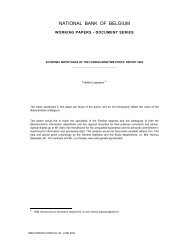Working Paper Research - Nationale Bank van België
Working Paper Research - Nationale Bank van België
Working Paper Research - Nationale Bank van België
You also want an ePaper? Increase the reach of your titles
YUMPU automatically turns print PDFs into web optimized ePapers that Google loves.
different instruments of quantitative control which the monetary authorities were applying,especially the "redeployment" coefficient, whereby banks had to invest a significant part of theirresources in government paper (Collin, 1977). They were a great nuisance for the Banque deBruxelles 13 . In the early 1960s, Lamfalussy was entrusted with responsibilities in the area ofinvestment management 14 . He was involved in the creation of certain mutual funds, which theBanque de Bruxelles introduced in the Belgian market. He also played a role in internationalinvestment banking, an area which was just emerging at the time. For instance, in July 1963, herepresented the Banque de Bruxelles at the signing of the subscription agreement for the firstEurobond issue, a $15 million bond for Autostrada (Norman, 2007, p. 95). Lamfalussy became anexpert on the Eurobond market. He was even invited to give a lecture at the Institute of <strong>Bank</strong>ers inLondon on this theme (Lamfalussy, 1968b). He also wrote a book on European financial markets(Lamfalussy, 1968a). However, during Lamfalussy's time at the helm of the Banque de Bruxelles, in1974, some traders took important open foreign exchange positions, which caused significantlosses for the bank (Moitroux, 1995, p. 217) 15 . It became Lamfalussy's first exercise in financialcrisis management. The National <strong>Bank</strong> of Belgium also opened special discount and credit facilitiesfor the Banque de Bruxelles (which, however, were not used, PV CD no 3479/19 of 26 November1974, NBBA) 16 . The issue was the topic of intense debates in the Belgian Parliament and inducedthe Government to introduce new legal dispositions to strengthen banking supervision in Belgium(De Clercq, 1975). At the end of 1975, Lamfalussy resigned from the bank. Evidently, all this had astrong impact on Lamfalussy's view of the financial system: risk and financial fragility becameimportant preoccupations for him 17 .During his time at the Banque de Bruxelles, Lamfalussy's research interests shifted to monetaryand financial issues, both national and international. Lamfalussy was intellectually close to theRadcliffe Report. In an article in The <strong>Bank</strong>er, he defended the Radcliffe Report against criticismfrom Robertson and Harrod who argued that the principle of "loans create deposits" applies only tobanks. In their view, all other financial institutions were pure intermediaries, who can only lend what13 Camu even argued it led to a paradoxal division of labour between private and public credit institutions:"Au lendemain de la seconde guerre mondiale, les intermédiaires financiers furent spécialisés et lesmarchés compartimentés. Il y avait un croisement d'attributions anormal: les institutions publiquesdéveloppaient, souvent avec l'aide de l'Etat, leurs crédits aux entreprises privées, alors que les banquesse voyaient contraintes de remettre les deux tiers de leurs dépôts à l'Etat" (Camu, 1977, p. 39). ("Justafter the Second World War, financial intermediaries were specialised and markets fragmented. Therewas an abnormal overlap of remits: public institutions were developing their lending to private enterprises,often with the help of the State, while the banks felt obliged to hand back two-thirds of their deposits to theState".) Naturally, with the memory of the Great Depression still vivid, these coefficients were alsointroduced for prudential reasons.14 Later, he also became responsible for the agency network in Wallonia.15 The breakdown of the Bretton Woods system marked an important turning point in the environment inwhich financial institutions operated. It implied a significant increase in the risks of foreign exchange andarbitrage operations. At that time, there were no prudential regulations concerning open foreign exchangepositions in Belgium. After the Banque de Bruxelles announced its foreign exchange losses, it received atelex from a German bank, saying "Join the club" (Moitroux, 1995, p. 217).16 The BIS was very closely involved in the unwinding of the foreign exchange positions (PV CD no 3460/14of 15 October 1974, NBBA).17 For instance, later at the BIS, Lamfalussy was to pay major attention to risk control and the internal audit.7
















